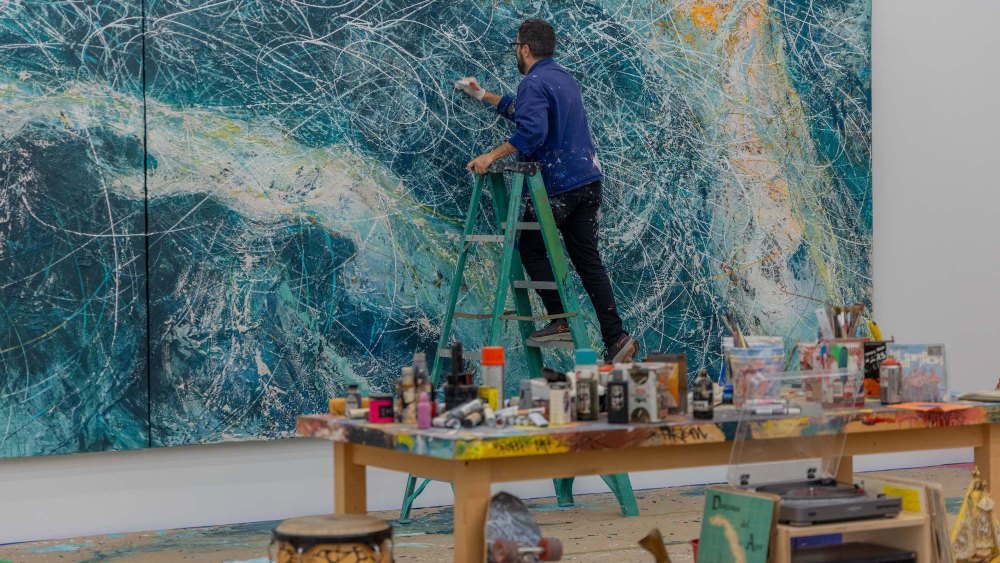A few weeks before the opening of “Homecoming” at the Pérez Art Museum Miami, artist José Parlá was surprised to find himself not in Miami but inside his Brooklyn studio.
“My mind was all over the place, so I kind of forgot that I was walking into the museum,” says Parlá, who was in Miami for the show’s install. “It was quite shocking that it felt just like my studio.”
In a way, the feeling was accurate; Parlá has recreated his Brooklyn studio inside the museum as part of his solo exhibition. He’s long wanted to bring his studio to life within the context of an exhibition, and curator Maritza M. Lacayo and PAMM director Franklin Sirmans were enthusiastic partners in offering the public a glimpse into the artist’s creative process beyond the physical act of painting. “There are symbols that you find through the journey of seeing the tables, the palettes, the materials. Some of the materials date back 25 years,” he says of the installation.

Parlá curated personal ephemera within the studio installation, including selections from his record collection and objects from international travels. In late October, he cued up his record player and invited the public to watch as he completed his 28-foot mural, titled “Homecoming, Before Time, the Earliest Migrations.”
You May Also Like
“The studio is an adaptation and a translation of all my journeys, my adventures,” says Parlá, who turned 50 last year. “I’m bringing them back home to share through these paintings and through this method of studio space in a museum.”

One interpretation of “home” is Miami, where Parlá grew up. The PAMM exhibition can be viewed as a full-circle moment tracing his physical return to his hometown. One work, “Return to Miami’s Ancestral Circle,” is a literal circular canvas, a rising sun of yellow and orange. But the exhibition speaks to more complex homecomings, both personal and collective.
“This exhibition is not so much about this traditional homecoming, where you leave and come back. It’s really a question about our times,” he says.
“Maritza and I started talking about it almost three years ago,” he adds of the exhibition’s origin. “She came to visit me as I was still recovering from my near-death experience. I was very weak and exhausted; my lungs didn’t work well. I had been in the hospital for four months in a coma, and an additional month recovering, relearning how to walk, eat, and everything. I was moved by this idea of a homecoming, because, to me, it was coming back to life, and back to where I was born in Miami. But I also see it as connecting to the region and the many stories that Miami is built of.”
“’Homecoming’ really is about: what is home for people?” says Parlá, whose family moved to Miami from Cuba in the 1970s. “A lot of us are going through displacement for various reasons. You make your home because of opportunities, or because of political upheaval that makes people leave in search for a better life or safety. So all of these things are part of the conversation.”

Paintings on view include the diptych “Breath of Life, Inhale and Exhale,” and “A Life of Memories Racing Through Art Deco Miami Beach Avenues,” which reflects the city’s architecture through beachy hues, creating an almost nostalgic effect. His abstract approach leaves much open to interpretation, although the titles hint to the personal inspiration behind the work.
“There’s this massive connection that goes beyond what the art is about. It’s so much more, it’s about humanity,” he says. “Abstraction can allow the viewer to think about reality beyond what we think reality is. And abstraction creates this very universal language. So a lot of the titles really deal with those themes.”

Asked about the relationship between the titles and the visual image, Parlá says, “I have to take you back to when I came out of the hospital in June of 2021. I was a brand-new person — literally, physically brand new. The doctors explained to me that in the process of what I went through, my entire insides changed.”
While in a coma, caused by COVID-19, Parlá experienced vivid narrative dreams that registered as real memories when he woke up. He dreamt of traveling the world to places — Australia, Hong Kong, Japan — that he had visited in real life. In those dreams, he was a hotel owner checking on his hotels. “During that dreamscape, I was kidnapped,” he says, adding that a psychologist later told him that feeling of being kidnapped was common among coma survivors.
“A lot of my memories were gone,” he says. He’d had a stroke, and underwent physical therapy to regain movement and strength. “One of the things that was most therapeutic and cathartic for me was listening to music in the hospital. Music brought back a lot of memories from childhood.”
Parlá began making artwork again while still in the hospital, healing through his work and listening to music. Nurses noticed that his pain was lower when listening to music. “As a process of getting my arms to work — I was badly atrophied, so the doctor held my hands so I could hold the brush and paint, and that ignited the feeling of being a painter, and that brought more memories,” he says.
A series of small watercolors he painted in the hospital later inspired large-scale paintings, exhibited at the Brooklyn Museum. Additional exhibitions followed at Library Street Collective in Detroit, the Gana Art center in Seoul, and Ben Brown Fine Arts in London. He worked on the PAMM show while painting for other exhibitions, creating a web between the paintings. “All the works are linked. And you could even go as far back to the ‘It’s Yours’ show at the Bronx Museum, that opened a week before the pandemic shut down New York and the world,” he says.

Parlá describes Miami as a melting pot of cultures, religions, and music. His artwork reflects the collection of influences, from music and dance to visuals found while traveling and later incorporated into the work. “There’s a certain rhythm that I’m painting to, so there’s this polyrhythmic energy in the work that you can see. You can see it as these heritage trails of gestures. And the gestures do become dance-like, so all of that is inter interconnected,” he says. “There’s a lot of psychogeography in my work, and so a lot of the work is always connected to places — Havana, Cuba, Miami, Japan, Detroit, London — places that I have friends and relationships, and connected to my family roots. All of this ends up now in this body of work of ‘Homecoming.’”
Some of his paintings incorporate found ephemera from these cities, like posters and ads weathered by the elements. “There’s literally DNA of that city now in the painting. It’s a kind of excavation, and it’s been done in history before with artists of the new realism with Mimmo Rotella or Jacques Villeglé, or even in Arte Povera,” says Parlá. “In Cuba, a lot of the artists for generations worked with found objects, and so it’s become part of my own tradition as well.”

By bringing these outside influences — music, advertising — his work becomes a collective cultural memory document. In “American Mindscape,” Parla has included fragments of photo portraits that include only the person’s eye, casting a gaze back at the viewer. Obscured text on posters is unreadable, but familiar enough to spark the viewer’s memory as they try to remember the context for each one, using the clues of a distinct font or colorway. Most legible is a poster that reads “In the American Landscape,” and despite losing its original purpose, it has become part of Parlá’s work, itself firmly part of that landscape.
“Museums are traditionally known as where you archive the world’s creative history,” says Parlá, who designed his Brooklyn studio with exhibition planning in mind, a step in the archival assembly line.
“There’s all this history that comes from the urban setting and into the studio, where the studio is making a composite of reality to be archived,” he adds. “All of those translations are what I’m interested in, and what this show also reflects on; observing my surroundings and that all becomes part of the art making process. There’s never a moment where I’m not working, because I’m processing.”




